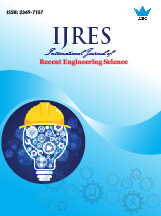Analysis of Level-Thinking Skills Distribution inthe Classrooms Assessment of the Elementary Schools: Based on Taxonomy Bloom’s Revision Theory
 |
International Journal of Recent Engineering Science (IJRES) |  |
| © 2017 by IJRES Journal | ||
| Volume-4 Issue-1 |
||
| Year of Publication : 2017 | ||
| Authors : Hafizhah Lukitasari, Sri Yamtinah, Peduk Rintayati |
||
| DOI : 10.14445/23497157/IJRES-V4I1P110 |
How to Cite?
Hafizhah Lukitasari, Sri Yamtinah, Peduk Rintayati, "Analysis of Level-Thinking Skills Distribution inthe Classrooms Assessment of the Elementary Schools: Based on Taxonomy Bloom’s Revision Theory," International Journal of Recent Engineering Science, vol. 4, no. 1, pp. 42-46, 2017. Crossref, https://doi.org/10.14445/23497157/IJRES-V4I1P110
Abstract
This research aimed to describe cognitive-level-thinking’s distribution in the classroom assessment based on Taxonomy Bloom’s theory that used by teachers for measuring students achievements in primary schools. This research used parallel mixed-method approach. The subject consists of 102 teachers from elementary school throughout Purbalingga Regency by stratified random sampling. Datas are collected by questionnaire technique for quantitative research and in-depth interview techniques for qualitative research.The research shows that Distribution of thinking level on exercises used by teachers are dominated by lower-order thinking skills while teachers are lack of preparing higher-level thinking skills questions. Questions of Primary School has not fully included the higher-order thinking skills.
Keywords
cognitive level thingking, assessment
Reference
[1] OECD. Global Competency for an Inclusive World (Paris: Directorate for Education and Skills, 2016)
[2] Kay. Middle Schools Preparing Young People for 21st Centrury Life and Work. Middle School Journal 40(5), 2009, 41-45
[3] Silva. Measuring Skills for 21st-Century Learning. The Phi Delta Kappan, 90(9), 2009, 630-634
[4] Anderson and Krathwohl.A Revision of Bloom's Taxonomy: An Overview. Theory Into Practice, 41(4), 2002, 212-218
[5] OECD. “PISA 2012 Results in Focus: What 15-year-olds Know and What They Can Do with What They Know”. Paris: Directorate for Education and Skills ,2014
[6] Mullis, Ina V.S. , Martin, Micahel O., Foy, P., Arora, A.TIMSS 2011 International Results in Sciences. Amsterdam: International Association for the Evaluation of Educational Achievement, (TIMSS and PIRLS, 2012)
[7] Duskri, Kumaidi, dan Suryanto. Pengembangan Tes Diagnostik Kesulitan Belajar Matematika SD.Jurnal Penelitian dan Evaluasi Pendidikan 18 (1), 2014, 44-56
[8] Badan Akreditasi Nasional Sekolah/Madrasah.Pedoman Akreditasi (Jakarta BAN, 2014).
[9] Gronlund, E.&Linn, Robert L. Measurement and Evaluation in Teaching (Macmillan Publising Company, 1990).
[10] Purwanto. Prinsip-prinsip dan Teknik Evaluasi Pembelajaran(Bandung: Remaja Rosdakarya, 2010)
[11] Kusaeri and Suprananto. Pengukuran dan Penilaian Pendidikan(Yogyakarta: Graha Ilmu, 2012)
[12] Stiggins, R.J, Arter, A., Chappuis, J., Chappuis S.Classroom Assessment for Student Learning: Doing it Right -- Using it Well. (Assessment Training Instritute, 2004).
[13] Peraturan Menteri Pendidikan dan Kebudayaan Republik Indonesia Nomor 22 Tahun 2006 tentang Standar Isi untuk Pendidikan Dasar dan Menengah.
[14] Anderson, L.W. dan D.R. Krathwohl. Kerangka Landasan untuk Pembelajaran, Pengajaran, dan Asessmen (Penerjemah: Prihantoro, A. dari A Taxonomy for Learning Teaching, and Assessing: A Revision of Bloom’s Taxonomy of Educational Objective A Bridged Edition: Addison Wesley Longman, Inc. 2001) (Yogyakarta: Pustaka Pelajar, 2010)
[15] Limbach, B. dan Waugh, W. Developing Higher-Order Thinking. Journal of Instructional Paedagogies 3 (1), 2010, 1-9
[16] O’Dowd, Gregory V.G. Developing Higher Order Thinking Skills in Medical Students. Hamamatsu University School of Medicine, 21, 2007
[17] Ramirez, Rachel P.B. & Ganaden, Mildred S. Creative Activities and Student’s Higher Order Thinking Skills. Education Quarterly 66 (1), 2008, 22-23
[18] Thompson, Tony. Mathematics Teachers Interpretation of Higher Order Thinking in Bloom’s Taxonomy. International Electronic Journal of Mathematics Education25 (1), 2008, 22-31
[19] Lewy, Zulkardi, Nyimas Asiyah. Pengembangan Soal untuk Mengukur Kemampuan Berpikir Tingkat Tinggi Pokok Bahasan Barisan dan Deret Bilangan di Kelas IX Akselerasi SMP Xaverius Maria Palembang. Jurnal Pendidikan Matematika, 3 (2), 2009, 14-28
[20] Lissa, Prasetyo, and Indriyanti. Pengembangan Instrumen Penilaian Keterampilan Berpikir Tingkat Tinggi Materi Sistem Respirasi dan Ekskresi. Lembaran Ilmu Kependidikan 41 (1), 2012, 27-32
[21] Vijayaratman Vijayaratman, Phawani. Developing Higher Order Thinking Skills and Team Commitment via Group Problem Solving a Bridge to the Real World.Procedia Social and Behavioural Science 66, 2012, 53-63
[22] Istiyono, Mardapi, and Suparno. Pengembangan Tes Kemampuan Berpikir Tingkat Tinggi Fisika (PhsyTHOTS) Peserta Didik SMA. Jurnal Penelitian dan Evaluasi Pendidikan 18 (1), 2014, 1-12
[23] Saido, et.al. Higher-Order Thinking Skills Among Secondary School Students in Science Learning. The Malaysian Online Journal of Educational Science 3 (3), 2015, 13-20
[24] Hartini and Sukarjo. Pengembangan Higher Order Thinking Multiple Choice Test untuk Mengukur Keterampilan Berpikir Kritis IPA Kelas VII SMP/MTs. Jurnal Inovasi pendidikan IPA 1 (1), 2015, 86-101
[25] Hesse, Nagy, dan Biber. Mixed Methods Research: Merging Theory with Practice (New York: The Guldford Press, 2010)
[26] Sarwono, Jonathan. Mixed Methods: Cara Menggabung Riset Kuantitatif dan Riset Kualitatif Secara Benar (Jakarta: Elex Media Komputindo, 2011)
